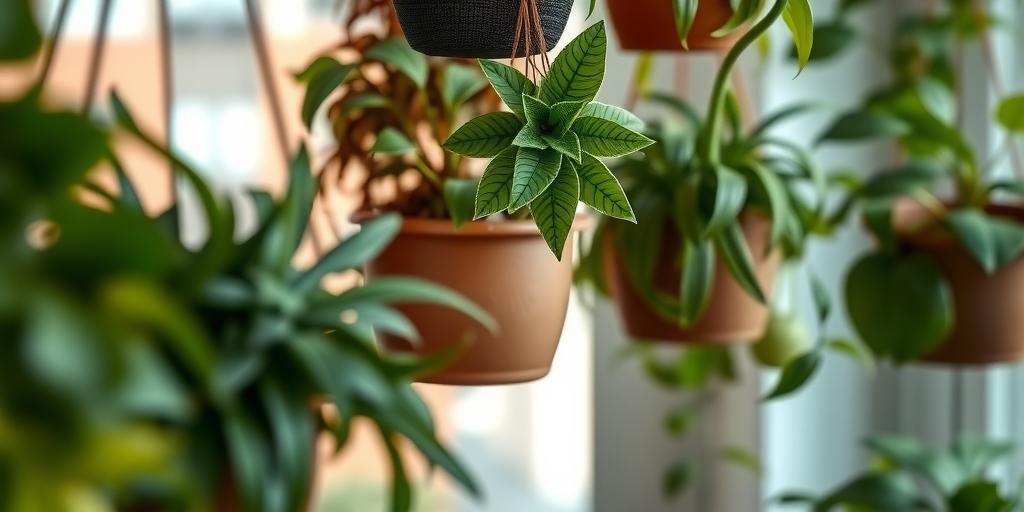
Top Low Light Hanging Plants That Thrive in Humid Environments
Discover the best low light hanging plants perfect for humid spaces! From lush pothos to elegant ferns, this guide covers easy-care plants that thrive in dim, moist conditions.
Introduction
Do you struggle to find the perfect plants for that shady, humid corner of your home? You’re not alone! Many indoor gardeners face the challenge of low light and high humidity, but the good news is—there are plenty of gorgeous hanging plants that love these conditions. Whether you’re sprucing up a bathroom, basement, or any dimly lit space, these resilient plants will bring life to your home without demanding constant sunlight. Let’s dive into the best low light hanging plants that flourish in moisture-rich environments!
Best Low Light Hanging Plants for Humid Spaces
Pothos (Epipremnum aureum)
If you’re looking for a plant that’s nearly impossible to kill, pothos is your best bet. This hardy vine thrives in low light and absolutely loves humidity, making it perfect for bathrooms or kitchens. Its heart-shaped leaves come in various shades, from deep green to variegated yellow and white. Plus, it grows quickly, so you’ll have long, trailing vines in no time.
Philodendron Heartleaf (Philodendron hederaceum)
Another low-maintenance superstar, the heartleaf philodendron, is a fast grower that adapts well to hanging baskets. Its glossy green leaves cascade beautifully, and it’s forgiving if you forget to water it occasionally. Like pothos, it thrives in humid environments, so it’s a great choice for steamy spaces.
Spider Plant (Chlorophytum comosum)
Spider plants are practically bulletproof. They tolerate low light, love humidity, and even help purify the air. Their arching leaves and tiny “spiderettes” (baby plants) add a playful touch to any room. Just keep the soil slightly moist, and they’ll reward you with lush growth.
Staghorn Fern (Platycerium spp.)
For something a little more unique, try a staghorn fern. These epiphytic plants have striking, antler-like fronds and thrive in humid, low-light conditions. They’re usually mounted on boards or hung in baskets, making them a stunning statement piece.
Peperomia (Peperomia spp.)
If you prefer compact, low-maintenance plants, peperomias are a fantastic choice. Their thick leaves retain water well, so they handle humidity like champs. They come in various textures and colors, from deep green to watermelon-striped varieties, adding visual interest without demanding much attention.
Why These Plants Thrive in Low Light & Humidity
Natural Habitat Adaptations
Most of these plants originate from tropical forests where sunlight filters through dense canopies. This means they’ve evolved to thrive in low-light conditions. Their ability to grow under tree cover makes them perfect for dimmer spots in your home.
Efficient Water Retention
Humidity-loving plants often have thick leaves (like peperomias) or aerial roots (like pothos and philodendrons) that help them absorb moisture from the air. This adaptation allows them to flourish in steamy environments without needing constant watering.
Slow Growth in Low Light
One perk of low-light conditions? Slower growth. While these plants won’t grow as rapidly as they would in bright light, this means less frequent pruning and repotting—ideal for busy plant parents.
Care Tips for Low Light Hanging Plants
Watering
Keep the soil slightly moist but never soggy. Overwatering is a common killer of houseplants, especially in low light where evaporation is slower. Stick your finger an inch into the soil—if it’s dry, it’s time to water.
Humidity Control
If your home isn’t naturally humid, mist your plants regularly or place them on a pebble tray filled with water. Grouping plants together also helps create a mini-humid microclimate.
Fertilizing
During the growing season (spring and summer), feed your plants with a diluted liquid fertilizer once a month. Skip fertilizing in winter when growth slows down.
Pruning
Trim yellow or dead leaves to encourage new growth and keep your plants looking fresh. For trailing plants like pothos, occasional trimming can also promote bushier growth.
Styling Ideas for Hanging Plants in Humid Areas
Bathroom Greenery
Turn your bathroom into a lush oasis by hanging pothos or ferns near the shower. The steam from your baths will keep them happy, and their trailing vines add a spa-like vibe.
Kitchen Accents
Hang spider plants or philodendrons above windows or open shelves. They’ll thrive in the humidity from cooking and add a fresh, lively touch to the space.
Living Room Decor
Create a jungle effect by layering different hanging plants at varying heights. Mix textures—like the soft fronds of a fern with the glossy leaves of a philodendron—for a dynamic look.
Common Problems & Solutions
Yellow Leaves?
This usually signals overwatering. Check that your pot has proper drainage, and let the soil dry out a bit between waterings.
Brown Tips?
Low humidity is often the culprit. Increase moisture by misting, using a humidifier, or placing a water-filled pebble tray nearby.
Leggy Growth?
If your plant is stretching toward the light, rotate it occasionally for even exposure. If possible, move it to a slightly brighter spot (but still out of direct sun).
By choosing the right plants and following these care tips, you can enjoy lush, thriving greenery even in the dimmest, most humid corners of your home. Happy planting!
Conclusion
Transforming a dim, humid space into a lush green oasis is easier than you think! With the right low light hanging plants—like pothos, spider plants, and ferns—you can enjoy vibrant foliage without constant sunlight. Ready to elevate your indoor jungle? Pick a plant from this list and watch it thrive!
